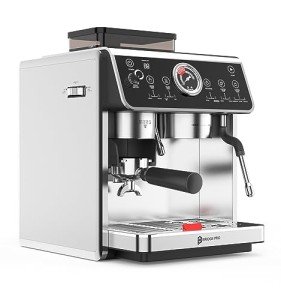5 Things That Everyone Is Misinformed About In Regards To Heat Exchange Espresso Machines
Heat Exchange Espresso Machines: A Comprehensive Guide
Espresso machines have actually developed significantly for many years, accommodating the needs of home baristas and coffee professionals alike. Among these machines, heat exchange espresso machines have gained appeal due to their ability to deliver consistent performance and exceptional brew quality. In this article, we will check out the operations, benefits, and crucial features of heat exchange espresso machines, offering an extensive understanding for both possible purchasers and coffee enthusiasts.
Understanding Heat Exchange Technology
Heat exchange espresso machines run on an unique principle that allows simultaneous water heating for developing and steaming. They are equipped with a single boiler that uses a heat exchanger system. This function is considerable as it makes it possible for users to brew espresso while steaming milk simultaneously, promoting performance in the coffee-making procedure.
How Does a Heat Exchange Espresso Machine Work?
The process starts with the machine's water inlet filling the boiler. As the water warms up, it turns to steam. The innovative heat exchanger uses hot steam to heat additional water in a different passage developed particularly for the brew group. This implies that water can reach the ideal brewing temperature without waiting for the boiler to adjust. The crucial actions consist of:
- Water Fill: Water is drawn into the boiler.
- Heating Process: The boiler warms up as water is converted into steam.
- Heat Exchange: Steam heats up water in the heat exchanger tube.
- Brewing: Water from the heat exchanger is pushed through coffee premises, extracting the tastes needed for a rich espresso.
This process enables quick temperature modifications and enhanced coffee extraction.
Advantages of Heat Exchange Espresso Machines
Heat exchange espresso machines offer several benefits, especially for those wanting to optimize their coffee experience. Here are some essential benefits:
- Simultaneous Brewing and Steaming: Users can brew espresso while steaming milk, making it ideal for busy coffee shops and home baristas who value effectiveness.
- Temperature Stability: The boiler's steam pressure helps preserve a steady temperature level, which is crucial for consistent espresso extraction.
- Flexibility: The design permits for fast changing between brewing and steaming, making it simpler to produce numerous coffee beverages, from lattes to cappuccinos.
- Easy to use: Models typically include available controls, making it possible for both newbies and knowledgeable baristas to produce quality beverages.
- Professional Quality: Heat exchange machines are frequently used in commercial settings, providing users with high-quality brewing performance in the house.
Secret Features to Look for in Heat Exchange Espresso Machines
When thinking about the purchase of a heat exchange espresso machine, there are a number of features that a person ought to take into account:
- Build Quality: Look for machines made of durable materials, such as stainless steel or brass, guaranteeing durability.
- Boiler Size: A larger boiler will hold more water and sustain higher output with time.
- PID Temperature Control: This function helps keep consistent brew temperatures, which can enhance the coffee-making process.
- Group Head Design: Machines with a saturated or semi-saturated group head offer better temperature level stability.
- Reduce of Use: User-friendly interfaces and user-friendly controls boost the overall experience for baristas at all ability levels.
- Steam Wand Quality: An excellent steam wand with proper insulation and flexibility enables for much better texturing of milk.
- Water Reservoir Size: Depending on your needs, think about how typically you wish to fill up the water reservoir.
Comparison of Popular Heat Exchange Espresso Machines
To much better understand the alternatives available in the market, listed below is a contrast table of some popular heat exchange espresso machines:
Machine Model
Boiler Size
PID Control
Cost Range
User Ratings
Profitec Pro 700
2.0 L
Yes
₤ 2,000-₤ 2,500
9.5/ 10
Rocket Espresso R58
1.8 L
Yes
₤ 2,400-₤ 2,800
9.4/ 10
Elekta Bianca
1.8 L
Yes
₤ 2,500-₤ 3,000
9.6/ 10
La Spaziale S1 Vivaldi II
1.5 L
Yes
₤ 1,800-₤ 2,200
9.2/ 10
Bezzera Magica
1.2 L
No
₤ 1,600-₤ 1,800
9.0/ 10
FAQs About Heat Exchange Espresso Machines
What is the main difference between a heat exchange and a dual boiler espresso machine?
While both types can brew espresso and steam milk at the exact same time, dual boiler machines have different boilers for developing and steaming. On the other hand, heat exchange machines use a single boiler and a heat exchanger to achieve the same function.
Are heat exchange machines ideal for novices?
Yes! Lots of heat exchange machines are created with user-friendly functions, making them accessible for beginners. With correct assistance and practice, users can quickly produce quality espresso.
What type of maintenance do heat exchange espresso machines need?
Routine maintenance consists of descaling, cleaning the boiler, examining seals and gaskets, and keeping the group head clean. Regular upkeep makes sure durability and constant performance.
Can I use a heat exchange machine for various types of coffee drinks?
Definitely! Heat exchange machines permit users to develop a variety of coffee beverages, consisting of espresso, lattes, cappuccinos, and more.
Heat exchange espresso machines represent a mix of innovation and tradition, supplying coffee lovers with the tools needed for crafting the ideal cup. Their ability to concurrently brew and steam, integrated with precise temperature control, makes them a compelling option for both home baristas and experts. With Manual Espresso Machines on functions and maintenance, users can open a world of elegant coffee experiences, making sure that each sip is as wonderful as the last.
